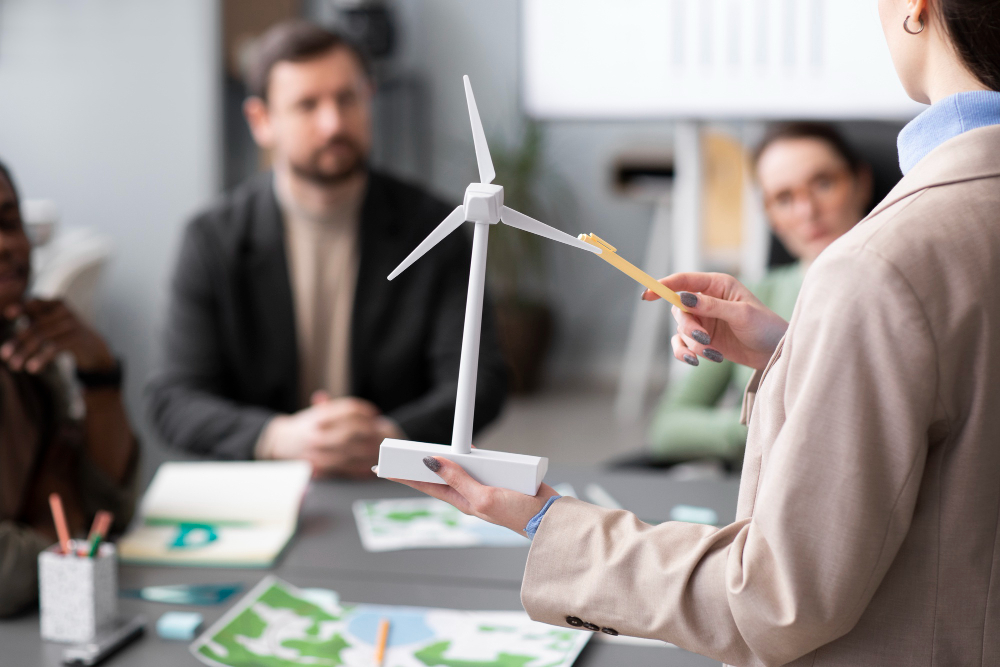해상용 풍력 발전 번역(한국어 원본)1. 서 론
녹색 성장에 발맞추어 유럽에서는 풍력에너지를 2020년 까지 전체 전력량의 12%까지 증가시키는 중장기 계획을 수립하고 있고 해상용 풍력발전기에 대한 관심이 높아지고 있다. 국내에서도 해상용 풍력발전의 더 많은 보급을 위해 정부의 지원 하에 지속적으로 연구, 개발이 진행되고 있다. 대형화된 해상용 풍력발전기가 개발되고 있으며 해상용 풍력 발전 시스템에 있어 구조적인 안정성 또한 필연적으로 대두 되고 있다.
해양용 풍력발전기의 하부구조물은 외부수압, 바람, 파도, 해류, 조수, 빙하, 지진 및 각종 기계설비로 부터의 하중을 받는다. 해양구조물의 파괴는 해양오염 및 해양자원개발의 손실뿐 만아니라 인명재산피해까지 이어 질 수 있으므로, 이의 구조적 안정성은 구조물의 설계와 관리에 있어서 아주 중요한 부분이다. 이에 사전에 해상 구조물의 건전성을 평가하기 위한 노력들이 선행 되어야 하고 이의 일환으로 해상의 환경 하중을 고려한 구조해석 방법의 모색 및 이를 통해 그 영향의 정도 및 경향을 파악하고자 한다.
본 논문에서는 CAE 범용 프로그램을 사용하여 해양 환경 하중을 고려하여 자켓형 해상 풍력 발전기 하부구조물의 기초설계를 진행하였다. 기초설계 된 자켓형 하부구조물의 구조해석을 수행 하여 응력상태 비교 연구를 수행하였다.
2. 해상용 풍력 발전 시스템
해상용 풍력발전 시스템은 크게 블레이드, 허브, 나셀, 타워 및 하부 구조물의 5 부분으로 구분된다. 육상용 풍력발전기와 달리 해상에 설치하기 위한 별도의 하부 구조물(모노파일, 중력기초 콘크리트, Tripod, Jacket, Tripile 등)이 요구되고, 이를 타워부와 연결하기 위한 연결 기술이 필요하다. 타워는 주로 발전기의 진동과 바람의 영향을 받는 반면, 하부구조물은 타워하단에 설치되어 하부기초로 힘을 전달하는 구조로써 주로 해상환경의 영향을 받는 구조물이다. 본 논문에서는 Table 1의 5MW 타워를 상부구조물로 선택하고 해양구조물 중에서 많이 사용되는 자켓타입 하부 구조물을 선택하였다. 자켓타입 하부구조물은 4-leg 타입이며 하부의 leg 간격은 18m , 상부는 5m, 높이는 45m 의 자켓으로 설계하였다. brace의 형태는 가장 사용도가 높은 x-brace를 적용하였다. 여기서는 40m 자켓에 Leg는 1.3m 외경으로 설정하였고 brace는 0.6m 외경을 사용하였다.
해상용 풍력 발전기 자켓타입 하부 구조물에 적용되는 Material Property는 일반 구조용 강(steel)으로써 Table 2에 나타 내었다.
3. 해양 환경 조건
3.1 Wave Theory
선형파 이론은 모든 파이론들 중에서 가장 단순하고 효율적인 파이론 이다. 선형 파이론을 유도하는데 기본 가정은 파고 H가 파장 L과 수심 d보다 매우 작은 경우 이다. 이 가정은 자유수면 경계조건이 파의 2차 이상 고차 항들의 영향을 소거할 수 있도록 허용하고 있다. 파의 수면 형상은 다음 식으로 표현한다.
3.2 Wave Load
일반적인 해양 구조물에 대한 파랑하중의 모델링은 Morison 방정식을 사용한다. Morison 방정식은 일반적으로 파장에 비해 구조물이 작을 때, 구조물의 길이 D와 파장 L에 대한 비가 0.2 이하일 때, 점성 항력이 관성력 보다 크게 작용할 때 사용한다. 구조물과 유체의 상대 운동을 고려한 Morison 방정식은 다음과 같다. (2) |
해상용 풍력 발전 번역(영어 번역본)1. Introduction
In step with the green growth movement, Europe is planning to increase the ratio of wind energy to 12% of total power by the year 2020, and interest in offshore wind generator is growing. Also in Korea, research and development is under way with government support for wider distribution of offshore wind power. Large offshore wind turbines are being developed, and the issue of structural stability is inevitably raised.
The substructure of offshore wind turbine receives load from external water pressure, wind, waves, ocean current, tide, glacier, earthquake, and various mechanical equipments. Because destruction of offshore structure results in not only ocean pollution and loss of marine resources but also casualty and property damage, the structural stability of these structures is very important in design and maintenance. Accordingly, evaluation of structural integrity of offshore structure is required prior to construction. As a part of this effort, a method for structural analysis of marine environmental load has been researched and the extent and trend of the effect is assessed.
In this paper, CAE program was used to analyze marine environmental load and perform basic design of jacket type offshore wind turbine. Structural analysis of the designed jacket type substructure was performed for comparison of stress states.
2. Offshore wind power generator system
Offshore wind power generator system is mainly divided into blade, hub, nacelle, tower, and substructure. Unlike wind turbine on land, offshore wind turbine requires additional substructures (monopile, gravity foundation concrete, tripod, jacket, tripile, etc.) and technology for connection to the tower. The tower is mainly affected by vibration from the generator and wind, while the substructure passes load to the lower foundation installed below the tower and is mainly affected by marine environment. In this paper, 5MW tower in Table 1 was selected as the superstructure and the jacket type substructure, which is most frequently used in offshore structure, was selected as the substructure. Jacket type substructure is of 4-leg type. For the design, jacket-type was selected, and lower leg interval was set to 18m, upper leg interval to 5m, and height to 45m. For brace, most frequently used x-brace was used. Here, jacket was set to 40m, outer diameter of the leg was set to 1.3m, and outer diameter of the brace was set to 0.6m. The material property of general steel used in jacket type substructure of offshore wind is shown in Table 2.
3. Marine environment conditions
3.1 Wave Theory
The linear wave theory is the simplest and most efficient of all wave theories. The basic assumption in derivation of linear wave theory is that wave height H is very small compared to wavelength L and water depth d. This assumption allows elimination of 2nd order and higher order terms. Wave profile of the wave is expressed using the following equation.
3.2 Wave Load
Modeling of wave load on general offshore structure is performed using Morison equation. Morison equation is used when the structure is relatively small compared to wavelength, the ratio of structure length D and wavelength L is smaller than 0.2, and viscous drag is larger than inertia force. Morison equation that accounts for relative motion of the structure and fluid is given as follows (2). |

